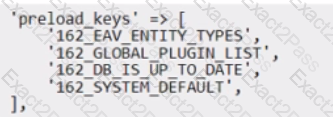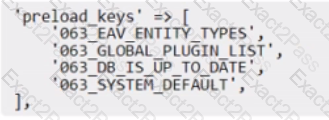Last Update 2 hours ago Total Questions : 50
The Adobe Commerce Architect Master content is now fully updated, with all current exam questions added 2 hours ago. Deciding to include AD0-E722 practice exam questions in your study plan goes far beyond basic test preparation.
You'll find that our AD0-E722 exam questions frequently feature detailed scenarios and practical problem-solving exercises that directly mirror industry challenges. Engaging with these AD0-E722 sample sets allows you to effectively manage your time and pace yourself, giving you the ability to finish any Adobe Commerce Architect Master practice test comfortably within the allotted time.
An Adobe Commerce Architect designs a data flow that contains a new product type with its own custom pricing logic to meet a merchant requirement. Which three steps are required when adding a product type with custom pricing? (Choose three.)
An Adobe Commerce Architect needs to ensure zero downtime during the deployment process of Adobe Commerce on-premises. Which two steps should the Architect follow? (Choose two.)
An Architect is configuring the preload.keys for Redis on an Adobe Commerce on-premise instance.
The Architect discovers that the following cache keys are loaded on each frontend request: EAV_ENTITY_TYPES, GLOBAL_PLUGIN_LIST, DB_IS_UP_TO_DATE, SYSTEM_DEFAULT.
• The id_prefix of the frontend => page_cache is set to 063_.
• The id_pref ix of frontend => default is set to 762_.
• The Architect has enabled and configured Redis L2 caching.
How should the preload.keys be configured?
A)

B)

C)

D)

An Adobe Commerce Architect is setting up a Development environment for an on-premises project that will be used for developers to specifically test functionality, not performance, before being passed to the Testing team.
The Magento application must run with the following requirements:
1. Errors should be logged and hidden from the user
2. Cache mode can only be changed from Command Line
3. Static files should be created dynamically and then cached
Which Application Mode is required to achieve this?
An Adobe Commerce Architect creates a stopword for the Italian locale named stopwordsjtJT.csv and changes the stopword directory to the following:
What is the correct approach to change the stopwords directory inside the custom module?
Due to a marketing campaign, a website is experiencing a very large number of simultaneously placed orders, which is affecting checkout performance. The website is in the production deploy mode.
Which two website settings can an Architect optimize to decrease the impact on checkout performance? (Choose two.)
The development of an Adobe Commerce website is complete. The website is ready to be rolled out on the production environment.
An Architect designed the system to run in a distributed architecture made up of multiple backend webservers that process requests behind a Load Balancer.
After deploying the system and accessing the website for the first time, users cannot access the Customer Dashboard after logging in. The website keeps redirecting users to the sign-in page even though the users have successfully logged in The Architect determines that the session is not being
saved properly.
In the "app/etc/env.php", the session is configured as follows:

What should the Architect do to correct this issue?

